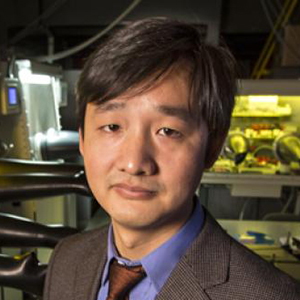Calendar Icon
Jan 23, 2015
![]() RSS
Submit a Story
RSS
Submit a Story

A team of UNL researchers led by Jinsong Huang, associate professor of Mechanical and Materials Engineering, and Alexei Gruverman, professor of Physics and Astronomy, had a paper on its discovery of a giant switchable photovoltaic effect in organometal trihalide perovskite devices published in the December 2014 edition of the prestigious journal Nature Materials.
The research team also includes engineering graduate students Zhengguo Xiao, Yuchuan Shao, Qi Wang and Cheng Bi, engineering post doctorate research associate Qingfeng Dong, engineering research scientist Yongbo Yuan, and physics post doctorate research associate Pankaj Sharma.
The team found that solar cells that have organometal trihalide perovskite (OHP) devices can produce a switchable photocurrent when a small electric field is applied to the surface.
"In a regular photo cell, there is no way you can switch it from positive to negative. Here we found that the photovoltaic effect, when you shine light into the device and you create electric current, a cathode can become an anode and an anode can become a cathode," Huang said.
This effect, Huang said, has created wattage outputs of nearly 100 volts greater than standard solar cells. Also, Huang said, with perovskite materials being abundant and relatively inexpensive, it could lead to more efficient solar cells that can be produced at a lower cost.
In his research at UNL, Huang found that perovskite easily soaks up sunlight and allows electrons to move freely within it, thus facilitating the conversion of solar radiation into electricity. When paired with silicon, which captures different wavelengths of light, perovskite allows a cell to harvest a broader spectrum of solar energy than either material could alone.
Nature is considered one of the leading international science journals, and Nature Materials is one of its sister journals. This is the second paper that Huang has had published in Nature Materials, and the sixth in one of the various Nature journals, since he came to UNL.
Submit a Story